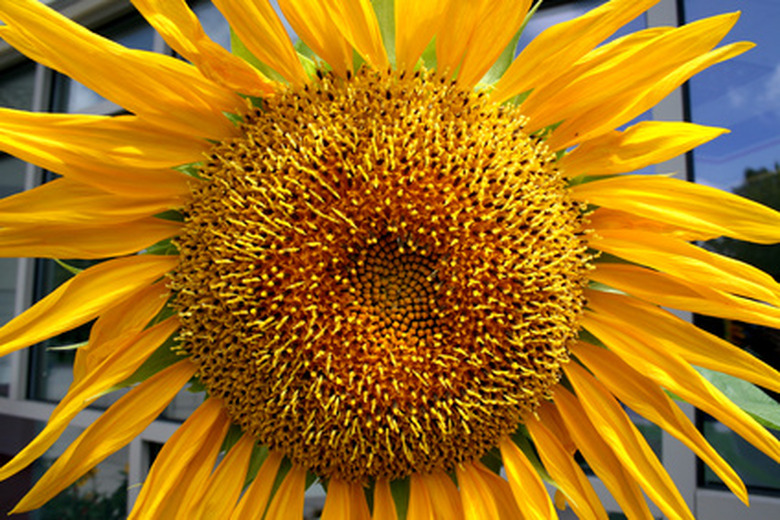The Life Cycle Of A Sunflower Plant
Synonymous with sunny fields and prairie vistas, the sunflower (Helianthus annuus) grows quickly, germinating, flowering and dying within one growing season. This annual plant grows in any fertile soil that is neutral or alkaline in pH and remains warm, moist and well draining. Many varieties of sunflower exist with different flower colors, sizes and mature plant heights.
Germination
When covered with 1/4- to 1/2-inch of moist soil, the sunflower seed takes five to 12 days to germinate after planted. Germination occurs in soil temperatures as low as 39 degrees Fahrenheit but hastens considerably when soil temperatures remain above 60 to 70 degrees. The hard seed coat softens in the damp soil to allow the first root to pierce downward and the first leaves, the cotyledons to push to the soil surface.
Growth
Researchers at Purdue University note that optimal growth of sunflower occurs when temperatures hover between 70 and 78 degrees Fahrenheit. The taproot continues to grow downward as far as 6 feet to anchor the plant, while many fibrous roots radiate outward from the stem base in the top six inches of soil. The single stem grows hollow and smooth, revealing large spade-shaped leaves from the growing tip as it elongates. After about 30 days, the plant's growing tip reveals the first hints of development of the terminal flower bud. The plant stem becomes more woody and changes from being smooth and rounded to firm and angled.
- Synonymous with sunny fields and prairie vistas, the sunflower (Helianthus annuus) grows quickly, germinating, flowering and dying within one growing season.
- The taproot continues to grow downward as far as 6 feet to anchor the plant, while many fibrous roots radiate outward from the stem base in the top six inches of soil.
Flowering
About three weeks after the flower bud first becomes visible at the tip of the sunflower stem, it enlarges and begins to unfurl to reveal a flattened disk. Over the course of one week, the yellow ray florets, the petals, roll back on the flower head's edges and the disk florets bloom across the core of the sunflower blossom. Bees pollinate the disk florets. After about one week the sunflower drops its ray florets. Dormant buds lower down the plant stem may sprout from the base of leaves to develop into secondary flower heads.
Seed Development
Once the sunflower blossom finishes blooming, the central core of disc florets swell and develop into seeds, ripening over the course of about 30 days. Once ripe, each seed dries and gradually sheds away the ground below or is plucked away and eaten by a hungry bird or small rodent. As the seeds ripen in the head, the rest of the sunflower plant begins to wane with yellowing and aborting leaves as energy focuses on the seed head.
- About three weeks after the flower bud first becomes visible at the tip of the sunflower stem, it enlarges and begins to unfurl to reveal a flattened disk.
- As the seeds ripen in the head, the rest of the sunflower plant begins to wane with yellowing and aborting leaves as energy focuses on the seed head.
Death
Once seeds ripen and naturally shed, the sunflower plant stops growth. Plants do not die until nighttime temperatures drop below 28 degree Fahrenheit. Even if temperatures in fall and winter do not drop below freezing, the sunflower plant dies since the climax of its life, the flowering and production of seeds, has occurred.
References
- Purdue University: Sunflower
- "A-Z Encyclopedia of Garden Plants;" Editors Christopher Brickell and H. Marc Cathey; 2004
